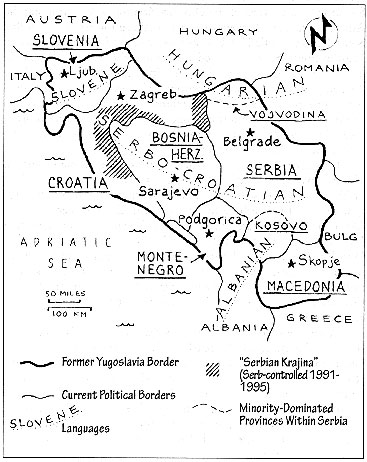Seems like this might be a good time for a quick history lesson... Feel free to skip this part.
Yugoslavia History 101
Prior to 1990 Yugoslavia was a large country with a number of different ethnic groups. Between WWII and 1980, The President known as "Tito" broke the country up into six different republics mostly based on those ethnic groups. Croatia (mostly Catholic Croats), Slovenia (mostly Catholic Slovenes), Serbia (mostly Orthodox Serbs), Bosnia-Herzegovina (mostly Muslim Bosniaks), Montenegro (mostly Serb-like Montenegrins), and Macedonia (mostly Macedonians with Albanians in Kosovo). Things were mostly peaceful until Tito's death in 1980. When Slobodan Milosevic took over Serbia and encouraged ethnic-motivated conflicts to increase his power, the country of Yugoslavia started to fall apart.
Slovenia was the first country to revolt, they held a free election in 1990 to abandon the countries communist roots and declare themselves an independent nation. The Yugoslav National Army tried to take over the borders, but after a 10 day war and less than 100 deaths, they relented and let Slovenia have its freedom, when Slovenia gave up their weapons.
Croatia took a much more hard-line route, led by Franjo Tudman they adopted a form of the formerly Nazi led group known as the Ustase, including their flag and money. As a large portion of Croatia was populated by Serbians and had seen the results of the Ustase in WWII, they rose up against the Croats. The Yugoslav army (mostly Serbs) came in, and a very bloody war developed. Serbs were performing ethnic cleansing, and the Croatians were fleeing to the coastlines, the Yugoslav army even attacked the Medieval tourist city of Dubrovnik. The Croatian citizens continued to fight for their independence, with teenage boys grabbing their hunting rifles and fighting soldiers at night. They became known as the Dubrovnik Defenders.
The borders changed with the Serbs taking a large portion of Croatia. A ceasefire lasted for a few years, but in 1995 the Croats struck back after becoming much better equipped and performed their own cleansing, either chasing the Serbs back into the original Serbia, blowing up their homes or killing them. Very quickly the borders were re-established and a peace agreement was formed. Of the 600,000 Serbians that used to live in Croatia only a few thousand remain.
Bosnia-Herzegovina had it's own war starting in 1992, ethnic cleansing by the Serbs against the Bosniaks and Croats, resulted in retaliation and a 3-Way war raged for years. The establishment of 'rape camps' brought the attention of the world, and after a mostly ineffective UN force tried to suppress the violence, a peace accord was reached in 1995, and B-H was carefully divided up based on ethnicity.
Finally Kosovo rebelled in 1998 after years of poor treatment by the Serbs. Slobodan Milosevic sent in the army and began ethnic cleansing again. Thousands were murdered and hundreds of thousands fled into Albania and Macedonia. As a result NATO bombed Serb positions for two months, until the army left Kosovo in 1999.
After so much violence and bloodshed, public opinion was changing in Serbia, and in 2000 a number of non-violent student led opposition movements started PR strategies to gain support, and when Milosevic arrogantly called an early election, he lost by a landslide. Milosevic tried to claim the election was invalid, but the citizens marched on the parliament, and peacefully took back their nation. In 2001 Milosevic was arrested for war crimes, and after five years of trial, he died of a heart attack in his prison cell before he could be convicted. Croatia's Tudman died of cancer in 1999 before he could be tried for his war crimes.
It is later discovered the two evil leaders had worked closely together to orchestrate the bloody wars and had a plan to split Bosnia-Herzegovina between their two countries.
Now there is six independent countries where there used to be one...

The history lesson is over. Now you know where we are traveling, and I can continue the story.


